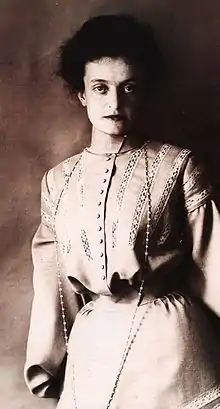Olena Kulchytska
Olena Kulchytska (Ukrainian: Олена Кульчицька; born 15 September 1877, Berezhany, Galicia – died 8 March 1967, Lviv) was a Ukrainian artist, teacher, and civil activist.
Olena Kulchytska | |
|---|---|
 Kulchytska in 1910 | |
| Born | 1877 Berezhany, Galicia |
| Died | 1967 Lviv, Ukraine |
| Occupation | Artist |
| Period | 1900–1967 |
Biography
Family
Olena Lvivna Kulchytska was born on September 15, 1877 in the town of Berezhany in the Ternopil region. Father — Lev Teodorovich Kulchytsky (1843 - December 4, 1909) — court counselor, lawyer, public figure, member of many societies. Mother — Maria Yakivna Kulchytska (? - December 29, 1939).
Learning and the first steps in art
In 1894 she graduated from an 8-grade school at the monastery in Lviv. For several months (1901-1902) she and her sister Olga attended the Lviv School of Arts and Crafts where she received her first lessons in watercolor.
Olena Kulchytska completed her art training at the private studio run by R. Bratkowski and S. Batowski-Kaczor in Lviv (1901–3) and the Vienna School of Industrial Design (1903–1908). After graduating, she took a year to travel through the major European art centres, including Munich, Paris, and London. Later in life, she worked as an art teacher at secondary schools in Lviv (Queen Jadwiga of Poland Gymnasium, 1909-1910) and Przemyśl girl school (1910–1938).
Privacy
The artist had no family of her own, she devoted her life entirely to art.
Work
Kulchytska’s first solo exhibition took place in Lviv in 1909. It showcased her engravings, prints, watercolours, woodcuts, and filigrees. The exhibition was celebrated by the early-modernist Ukrainian artists, for instance, Ivan Trush.[1] Kulchytska’s work combined the folk art traditions of the Western Ukraine, particularly, the Hutsuls, with the stylistic innovations of the European Sezession. Later, she exhibited her works in Krakow, Warsaw, Poznań, Kyiv, and other European cities.
During 1920-1930, Kulchytska made major contribution to the Ukrainian book design. She illustrated various works by Ivan Franko, Mykhailo Kotsiubynsky, Vasyl Stefanyk, and Yurii Fedkovych, as well as more than 70 books for children for the series «For Our Littlest Ones», which included Oscar Wilde’s ‘The Star-Child’ (1920).[2]
In the field of applied arts, she designed 80 kilims in collaboration with her sister Olha.
Activism
During the World War I, Kulchytska depicted the sufferings of the civilian population and refugees. Her works were reproduced as postcards by the Ukrainian Women's Committee to Aid Wounded Soldiers in Vienna.[3]
Kulchytska was part of the civil resistance movement under Stalinism.[4] She helped the families of those who were repressed and deported to Siberia.
In 1955, Kulchytska began campaigned against the closure of the Lviv Art College. She financially supported the Union for the Liberation of Ukraine.
References
- "Газета "Галицька брама". №9-10 - 1997 – Бібліотека українського мистецтва". Uartlib.org. 1997-10-09. Retrieved 2018-06-05.
- "Оскар Уайльд. Зоряний хлопчина. Ілюстрації Олени Кульчицької – Бібліотека українського мистецтва". Uartlib.org. Retrieved 2018-06-05.
- "Postcards and Photographs from the Eastern Front - European studies blog". blogs.bl.uk.
Further reading
- Олена Кульчицька (in Ukrainian). Kyïv: Mistetstvo. 1969.
- Holubet︠s︡ʹ, Mykola; Osinʹchuk, Mykhaĭla (1933). Олена Кульчицька (in Ukrainian). Lʹviv: ANUM.
External links
- Olena Kulchytska in Internet Encyclopedia of Ukraine
- Olena Kulchytska in Ukrainian Art Library
- See an issue dedicated to Olena Kulchytska in Halytska Brama, №9-10 (2007)